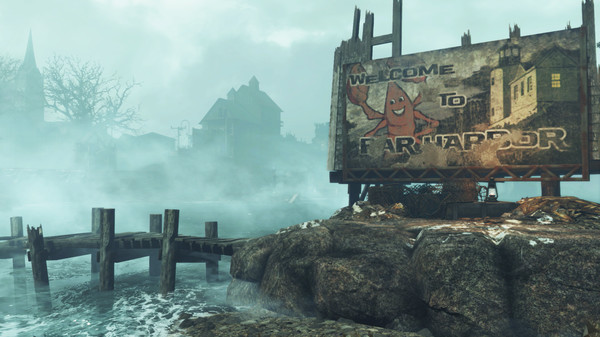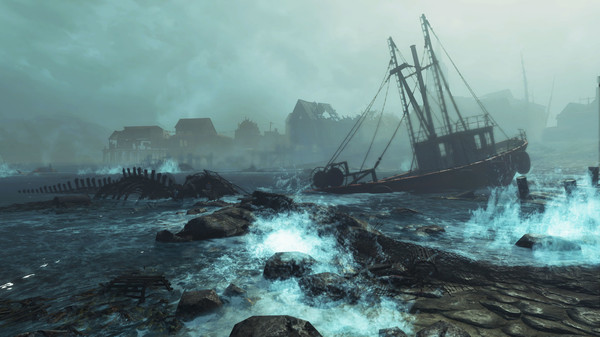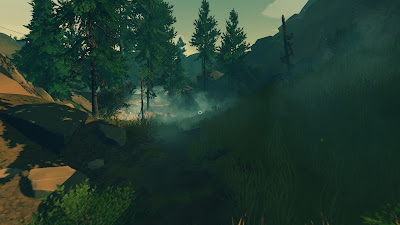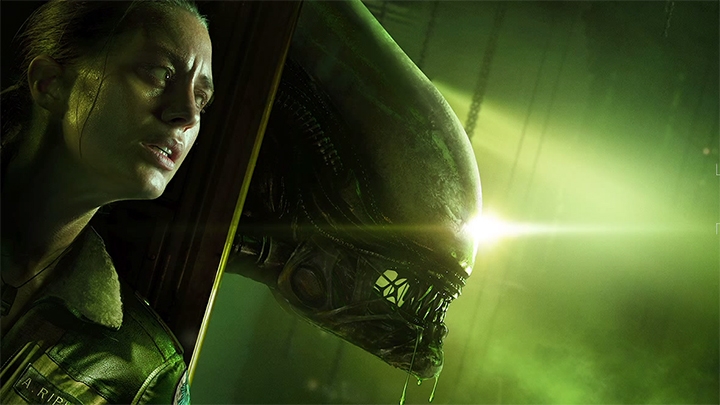Thursday, 13 October 2016
Mafia III
New Bordeaux, based on New Orleans, 1968 is not a place that I'm familiar with. There's no post-Katrina deluge of gray, or the dinky tunes of jazz playing in the background. There's little sign of the Marsalis family, or the presentation of a coastal city plagued by hurricanes. Instead it's the mafia who are the focus of New Bordeaux, presented among the background of history with the death of JFK, Martin Luther King, and the fallout of the Vietnam war setting the scene. Lincoln Clay rides around in his All American Samson Drifter rocking out to Steppenwolf, Johnny Cash, and Otis Redding as the mood strikes him taking out those who have wronged him in his revenge-fuelled rampage. It doesn't feel so much New Orleans during the late 60s but a statement about change in American culture, and how many people are still sorting out the aftermath.
Gameplay involves running and gunning, stealing items from the rival gangs, and forcibly taking over areas throughout New Bordeaux, in a similar fashion to Saints Row, or Far Cry 4's district allotment. The mission structure enables different sorts of presentations for the same sort of goals - you steal or destroy different items or men to force the current owner of the district to face you. The type of men and items change from district to district but largely operate in the same manner - cause as much ruckus as possible to fight the district owner and take over their land.
There is some variation with stealing different vehicles, or interrogating informants to lead you to an area where Lincoln can do further damage, or to steal further items/cash, but overall the playstyle remains the same. This repetition is fine especially since the music, AI and different locations do make each area feel different enough to still be enjoyable. The fact that each district is capped off with it's own particular story mission also breaks up the gameplay. This gives players a chance to have a setpiece where they confront the districts unique mob boss within their own hideout - ranging from the top of a hotel to a riverboat cruise. Though the gameplay does not make the game stand out.
The contention of Mafia III can be summed up in its enemies ranging from Redneck racist hillbillies, to the 'old mob,' all who are convinced they need to combat change to keep abreast of all these equal rights. Such presentation places Lincoln as a force of change - not for African-American rights, but rather a host of different groups allowing for equality of all races, as well as equality for those with different sexuality, or nationality. Although definitely taking a back seat to the murder and mayhem approach of Lincolns revenge narrative the fact that such motivation exists at all is reassuring - if a bit safe from the developers. Considering the proliferation of Black Panther movement, segregation being forcibly disbanded, and the move against conscription more could be done to position Lincoln, the player-character as a motivator for change.
Instead such talk is regulated to the back-channels of talk-back radio (between the hard right position of Remy Duvall and the left of WNBX radio hosts), through conversations between NPCs (natural order being disrupted because of equal rights), or racial slurs leveled at Lincoln. The quest arc does portray this as a central issue in the construction of Lincoln's revenge narrative (the kindly mob boss, Sal Marcano, turns out to be somewhat racially motivated), or in the takeover of a KKK-esque area (the racket sells racist material, and African Americans for sadistic sport). However Lincoln as a character doesn't respond to this in any particular way, except to state that this type of stuff is racist (with a few more expletives) and that he'd like to continue his revenge narrative. Other characters such as Father James, Lincoln's adoptive father Sammy Robinson, to the Haitian under-boss Cassandra, all do more for civil rights than the player-character does. Lincoln aids them somewhat, but always under the pretense that it will serve as fuel for his revenge. This engagement works within the overall presentation of Mafia III, but feels strangely safe in a game that's already positioning itself as reflecting on change.
What's important to note here is that the reasons for why such racism exists, as well as the response from the player-character, doesn't seem to involve more than a one word action of violence. Player choice is more or less limited to choosing to save or kill informants and the occasional mob boss, but beyond this the response approaching towards anything regarding a civil issue seems to not exist at all. (Potentially the player could heavily side with providing the Haitian subgroup with the most territory, this does not seem to enable civil engagement so much as increase your financial abilities. Ironically the other subgroups will get annoyed for not having territory of their own and turn on you). Then again most games tend to present themselves in a progressive light - Bioshock: Infinite with it's presentation of Columbia as a heavily racist fictional town only uses it as a backdrop to gun fights - Mafia III is no different. It introduces some of these ideas and figures as something which players can follow up on. Although not quite as limiting as 'the press x to lay respects' of Call of Duty: Advanced Warfare, an opportunity for the player to do more or at least engage more with the discourse would be appreciated.
In this Mafia III does break away from the traditional presentation of the Mafia series, it doesn't appear to do much more for civil rights. Through referencing the location, time period, and characters of a tumultuous time Mafia III can make use of the progressive themes of that period to simultaneously appeal to an idea of civil progress, whilst at the same time not pushing the envelope of what should occur.
Saturday, 21 May 2016
Far Harbor
So I booted up the premium content DLC pack last bit of the season pass for Fallout 4 over the weekend and I had a little play. A little play where I finished the main quest, gone through a bunch of dialogue with Nick Valentine, and resolved the settlement problems on the island. In all it was a lackluster experience not at all worth the 25 USD of the standalone nor the 50 USD of the season pass and would be buyers would be better off grabbing other games for the price of this DLC. For me personally this is due to a small quest pool, and quest depth (in terms of available actions), followed by janky game mechanics and a lack of character in many NPCs. However before reaching into that criticism lets look to what the DLC does correctly.
For the positives of the DLC, its all mainly constrained to the aesthetic content such as equipment, weapons and new area that the game showcases, however these while interesting almost fall into the modding level of quality in terms of what they add to the game. Other mods provide much of these improvements already to the game such as expanding on settlement behavior, adding in weapons, providing new aesthetic looks to players and NPCs. Nevertheless the quality and the scope of the DLC might be seen as slightly improved from modders, especially seeing as it is paid content. So depending on how much the art style of the DLC hits you, it can be considered as a nice bit of content for those who don't use mods.
That aside what Bethesda can alter and make use of (that many modders don't have is access to) are game mechanics, voice actors, and the ability to put in quality stories.
Voice acting within the DLC is largely good, but in terms of examining characters beyond the five or six lines of dialogue that they have reveals a lot of shallowness within the game world. Talking to Children of Atom reveals a very shallow conception of worship or religion. An option to ask why, or to challenge some convictions (including those of the Piratey Far Harbor) would make for some interesting conversation, but to a large part many NPCs play caricatures and are fixed in what they can say and do. That being said the same occurs within Fallout 4's main game, however there the game goes to a lot more effort to hide this lack of options, through scripted confrontations (through the follower quests or main quest). In Far Harbor this lack of options is too obvious for a suspension of disbelief to ignore.
The game mechanics consist a hacking tower defense mini-game that looks and plays worst than any hacker aesthetic tower defense I can think of (see Antichamber, Tron 2.0, Minecraft, Consortium's shooter training, Cradle's mini-games). This tower defense section was made using the workshop mechanics and as such makes for a frustrating experience.
 |
| Fallout 4: Far Harbor's minigame, and yes that overlay is always on the screen. |
To put this in perspective I spent a 15 minutes trying to put down a square block to complete a puzzle, simply because the clipping would cause the block to disappear among another one. Never mind the fact that this mini-game was not at all enjoyable, but also critical to finishing off the DLC's quest line.
 |
| Kellogg's dream sequence |
This especially in the light of Kellogg's dream sequence of Fallout 4's main game seems to be a surprising oversight in design - nearly anything could have been placed in that section, but they chose to have an uninspired, broken and visually bland level. It seems surprising that it was put in the game at all especially since all it does is unlocks an audio log. It seems to detract a lot from the DLC in terms of quality. The rest of the game falls into the 'hey watch out for radiation' or the shoot and loot which is the bread and butter of all Fallout games.
The story which carries players through to the DLC and through to different quests is an uninspired retelling of events that occurred in the first game.
In this the story of Far Harbour, largely a retelling of Fallout 4's narrative, fails since it adds nothing to the overall world of Fallout. For example plot of the DLC revolves around finding a missing girl and through that choosing the fate of three communities on an island. Fallout 4 revolves around finding a missing son (boy) and through that choosing the fate of three communities on a landmass. Of course there are some differences, but the main narrative beats (including that of a level in someone elses brain) doesn't provide any new surprises. The one interesting aspect of the plot questioning whether the player is a synth or human, is quickly forgotten among the gameplay of going to a location, kill enemies and collect an item.
The way in which the narratives complete seems to rely more on providing a neat end to stories by having factions or faction leaders dying off, rather than seeing how they can operate together. A compromise can be achieved by simply not completing quests, but the fact that there's no option provided by Bethesda to compromise is telling of the simplicity involved with all the quests in this DLC.
To emphasis this the backstory for each faction is kept an arms length away from quests. Meaning that any revelations the player makes about each community has no bearing on the quest options they can make. The fact that certain leaders were assassinated, are synths, or have history with other characters makes no difference to how players can complete quests. In the end of the DLC players find their missing girl, saving or kill the different factions on the island and go back to the Commonwealth - with little to no resolution provided by the game besides another gun.
In all it seems that the actions you take really do not matter in the scheme of things. Within Fallout 4's main game building settlements, completing companion quests, finding the player's son and talking to the different factions felt like a nuanced journey. This DLC seems like a mods attempt to emulate some of that scope, instead of doing its own thing.
Saturday, 2 April 2016
Shardlight and post apocalyptica
Shardlight Wadjet Eye Games gives you two things from its outset a strong female protagonist and a heavy setting of post-apocalyptica. Both of which promise a unique experience but then quickly falls into a series of safe tropes (government controlling the populace) that hold the promise of the game back. Though some of the puzzles work well, overall it's the lack of immediate class discord, or harshness in the world
Starting out your character Amy is tasked with fixing a reactor core for a post-apocalyptic city at the hopes of winning a lottery ticket for a vaccine to 'green lung.' Through this innocent task you're thrust into a class war between the everyday citizens who toil in post apocalyptica and the aristocrats who govern. For the most part the game presents each of these early plot points successfully, from a dying man's wish, to an asthmatic like fit for your character. These sections enabled the urgency of the plot to become apparent - dangerous jobs are taken by citizens to improve their chance of a cure, capitalising on their desperate measures. Mercy killings are rampant, and for all appearances life is cheap.
But the game doesn't carry on with it's life is cheap ethos, aside from killing a main-ish character later on, everyone in this post-apocalyptic world is accommodating. They act altruistically with every interaction, making sure that you're well looked after. This while refreshing seems to go against the setting of the game as something to be survived, and rather a community building exercise - something which the game could lean more heavily towards than pointing out a class struggle, that doesn't appear to be present, especially when all the characters you originally meet are autonomous and don't appear to be suffering from government intervention.
Green lung and the lottery seem to be the main points of contention for this class war, but with that the game doesn't present the plague as an epidemic, but rather something that people merely have to endure, and with that especially considering there's no direct stigma given for having green lung (though it is alluded to for other characters).
But this aside the game is a good one in it's engagement initially, with the immediate portrayal of a failing city, but the uncovering of the community and the stable political situation made much of the world fall apart. Far from being a hellscape of suffering it really just seemed that people were one conversation away from solving many of their woes.
If the threats portrayed within the game were indeed life threatening, or the lot of many citizens visibly made worse by the ruling class then this game would be much more palatable. As it is with the escalation of threats and the portrayal of political injustice it doesn't bring much new ideas to the themes presented. Going back to other Wadjet Eye Games, such as Primordia or Gemini Rue give a much more nuanced world where the world reflects much of the story. So while there are certainly sections which are presented well in the game - primarily the start - the execution overall lacks the polish of previous games.
Sunday, 14 February 2016
Firewatch
Firewatch is a very pretty game that recaptures the charm of Gone Home, and also Kentucky Route Zero in its gameplay mechanics (walking around) and use of dialogue (the fact that your responses are remembered within each playthrough). It's a fun game that doesn't take itself too seriously, but quickly turns from self exploration towards am investigation of the national park, ending eventually with an escape from a bush fire (or forest fire).
In Firewatch there's a distinct break from the start of the game which introduces your character as either taking a break from responsibilities, or shirking them entirely - this allows for a certain degree of player control over how they view their character of Henry and his relationships. It takes a certain amount of scurrying to see how the dialogue choices effects on the narrative, it appears to be almost coincidental in presentation. Until Dawn provides a similar effect to this providing a narrative that is slightly affected, maybe a word or two more, upon choices the player made previously. Firewatch provides a lesser experiences of this, there's no choice that provides an easier means of escape or traversal just different reasons/causes for the same events.
 |
| These dialogue choices are largely presented on this screen. |
You left home to escape your wife.
Or,
You took a break from caring about your wife.
You pose Superman style for a picture.
Or,
You pose like one of her French girls for a picture.
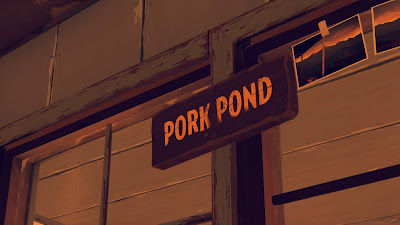 |
| This sign is alluded to earlier in the game. |
Incidental things which aren't necessary for the narrative to move on, but little things to make the game appear to be self aware. Firewatch presents these sections in a fairly prominent manner, leaving room for the knowledge that your choice is being reflected in the game - as opposed to the almost weaving nature of Kentucky Route Zero's meandering dialogue. It's an interesting implementation of player choice without changing the narrative too radically, but from its presentation there does not appear to be enough there to alter the narrative to any great deal. Which is understandable Firewatch is not one of those adventure games, it is one of those walking game Gone Home, Dear Esther, or Everyone Has Gone to Rapture. You exist in the world to see what happens, or what has happened, but you rarely affect it.
While these choices are presented giving a background to Henry, the game also introduces the main game mechanics walking, picking objects up and placing them, all of which seem to be getting Henry prepared for some sort of trip. From there the game jumps ahead into sections - from the carpark of an apartment complex, to the entrance of the Shoshone national park, to part way of the hike to , to finally the area in which you're firewatching, Two Pines lookout. You are pretty much restricted in what you can do, but the area that you explore is one that is a good introduction to the area. Eventually you make your way up to the Firetower set your pack down and answer your walkie talkie and meet Delilah. Who you answer one or two questions to, before heading off to sleep after a long hike - which can almost be considered a reference to the heavy exposition needed to get the character to Shoshone (something heavily read into it).
This sets up the rest of the game as waking up talking to Delilah and doing various national park duties, enjoying the serenity, and uncovering the history of who else has been in Shoshone park. It provides a nice bit of enjoyment for the most part, but then progresses a bit too quickly for the park to be truly enjoyed - or rather that's how it felt, it's hard to judge serenity in a game when you've got objectives to do. Which may be my criticism of the game in that it provides almost too much direction in what to do, and the speed in which you can do it instead of just sitting, thinking and seeing how the park works. There were a number of times I wanted to pause to look at this or that, but the sense of urgency presented in the game objectives meant that more often than not I'd be running around to specific points rather than meandering. Although this probably says more about myself than the insinuation of game objectives, the one chance to explore (as identified by Delilah) doesn't present itself again once the main "conspiracy" part of the game presents itself.
 |
| Nicely enough these pages changed with each day. |
This is somewhat countered by the Kodiak camera you get and are encouraged to take pictures with. At the end of the game it's revealed that you can mail order these photos for yourself - which is a nice piece of marketing/paratext/tie-in. Though this lost a bit of its overall charm as when I originally grabbed it I took scenic shots (which if I'm humble were great), but as the main plot progressed I started to take more shots of different sections as "evidence," as the game suggests you take some shots. Eventually when I ran out of film I just chose to take screenshots for my own enjoyment of the world. It seemed a bit counter intuitive to promote using the camera as something that was important to the plot and then not using it there. But I guess that's the difficulty of instituting free-play within a game system.
 |
| Case in point putting out fires. |
 |
| My Australian sensibilities were shocked that they didn't call this a dunnycan |
So Firewatch is an interesting game, that doesn't go too far with its strengths - the open world, the encouragement of serenity, the variance in dialogue, the conspiracy narrative - but far enough to make it novel and interesting. Other games individually make the most of these strengths, Far Cry 2 with it's open world (and depiction of serenity, wildlife and fires), Kentucky Route Zero in its variance of dialogue, Psychonauts in its conspiracy narrative/camping theme. But Firewatch manages to combine these elements into a single game. So if you're in the mood for being experimental, or finding a catchall mixup of the aforementioned games then go for it, otherwise if you're looking for something more specific then you might want to look elsewhere.
Wednesday, 3 February 2016
Back in Australia/SOMA thoughts
So I'm back again down under and with that back to working on the PhD and writing in general. I'll be attempting to update this blog more regularly from now on.
That being said I'm still settling in from travel and jetlag - so nothing too exciting for this week. What I can offer is some small discussion of stealth within SOMA (and by extension Amnesia and other horror games by the developer Frictional Games). Overall the game is great, but the approach of the stealth within this game is much more in line with hindering the player experience than enhancing it. You have to get past these blocks before the enjoyment of the game can come into play.
SOMA broadly can be seen as a step inbetween the horror genre and the "walking" simulators. Walking simulators such as Dear Esther or Gone Home are largely pushed by the player's discovery of each audio log or information which slowly brings them to an understanding of the world. In short an investigative game, where the mystery is figuring out the player-characters role in the world, but also what exactly the world is. The horror genre is a bit more traditional, being scared by the atmosphere, but also being chased by all sorts of grotesque figures. Another example of this mashup can be seen within Alien: Isolation which provides more gameplay variation in it's stealth and later combat.
Stealth in SOMA largely is due to monsters patrolling areas in which you have to do various tasks, or monsters guarding certain doors. Stealth is based upon the fact that the monsters have low visual perception, but high aural perception - running, walking and crawling all make noise, but you can always just freeze and wait for the monster in question to walk past. Where this breaks down is that the stealth largely turns into a waiting game, that is dictated by the monster's AI. Trying to move past these monsters draws attention to you, even if crawling, and making distraction noises (such as throwing an item) is much more likely to reset the monster's path to walk right by you rather than to push it further away from you. The level design too of narrow corridors makes choke points for the AI to bounce against, so you can be waiting for a while. Prior to the later levels there are open areas in which the AI can be circumvented, but for a large part of the "challenging" sections the player has to wait a while.
Or!
Alternatively the player can choose to run past the monsters to their key objective to make use of the health system within the game(which operates on a a two hit system, you get hit twice you die. However on the first hit the player-character goes unconscious while the AI resets somewhere else on the map. With this in mind many of the stealth sections can be circumvented through making the most of the game's health system.
The reason that this stealth system feels flat is due to the waiting nature of the gameplay. Although certainly a valid option for many stealth games Metal Gear Solid, Hitman: Blood Money, Splinter Cell, using it as one of the features of stealth-horror genre makes the game feel a little uninspired. The use of objects to throw to distract enemies is a great one within games, but the fact that the footsteps of the player can quickly nullify the distraction ends up making the gameplay sections a hindrance to the otherwise engaging plot. Applying more options for the stealth (combat, or more abilities to distract enemies), or providing alternative means of hindering the player (making further gameplay more difficult) might be two options worth exploring for making SOMA's stealth more enjoyable.
That being said I'm still settling in from travel and jetlag - so nothing too exciting for this week. What I can offer is some small discussion of stealth within SOMA (and by extension Amnesia and other horror games by the developer Frictional Games). Overall the game is great, but the approach of the stealth within this game is much more in line with hindering the player experience than enhancing it. You have to get past these blocks before the enjoyment of the game can come into play.
SOMA broadly can be seen as a step inbetween the horror genre and the "walking" simulators. Walking simulators such as Dear Esther or Gone Home are largely pushed by the player's discovery of each audio log or information which slowly brings them to an understanding of the world. In short an investigative game, where the mystery is figuring out the player-characters role in the world, but also what exactly the world is. The horror genre is a bit more traditional, being scared by the atmosphere, but also being chased by all sorts of grotesque figures. Another example of this mashup can be seen within Alien: Isolation which provides more gameplay variation in it's stealth and later combat.
Stealth in SOMA largely is due to monsters patrolling areas in which you have to do various tasks, or monsters guarding certain doors. Stealth is based upon the fact that the monsters have low visual perception, but high aural perception - running, walking and crawling all make noise, but you can always just freeze and wait for the monster in question to walk past. Where this breaks down is that the stealth largely turns into a waiting game, that is dictated by the monster's AI. Trying to move past these monsters draws attention to you, even if crawling, and making distraction noises (such as throwing an item) is much more likely to reset the monster's path to walk right by you rather than to push it further away from you. The level design too of narrow corridors makes choke points for the AI to bounce against, so you can be waiting for a while. Prior to the later levels there are open areas in which the AI can be circumvented, but for a large part of the "challenging" sections the player has to wait a while.
 |
| Said small corridor |
Or!
Alternatively the player can choose to run past the monsters to their key objective to make use of the health system within the game(which operates on a a two hit system, you get hit twice you die. However on the first hit the player-character goes unconscious while the AI resets somewhere else on the map. With this in mind many of the stealth sections can be circumvented through making the most of the game's health system.
 |
| Artist's impression |
The reason that this stealth system feels flat is due to the waiting nature of the gameplay. Although certainly a valid option for many stealth games Metal Gear Solid, Hitman: Blood Money, Splinter Cell, using it as one of the features of stealth-horror genre makes the game feel a little uninspired. The use of objects to throw to distract enemies is a great one within games, but the fact that the footsteps of the player can quickly nullify the distraction ends up making the gameplay sections a hindrance to the otherwise engaging plot. Applying more options for the stealth (combat, or more abilities to distract enemies), or providing alternative means of hindering the player (making further gameplay more difficult) might be two options worth exploring for making SOMA's stealth more enjoyable.
Subscribe to:
Posts (Atom)








